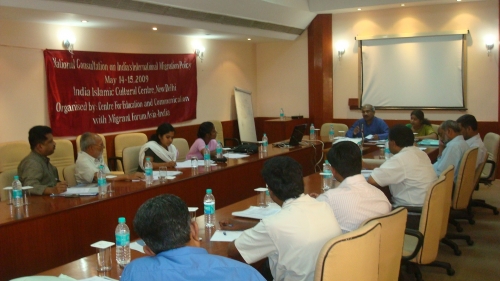Migrant Labour

Migration is of immense significance to India. According to the data of Ministry of Overseas Indian Affairs (MOIA), at present there are about fifty lakh overseas Indian workers all over the world. More than 90% of these workers are in the Gulf countries and Southeast Asia. Most of these workers are unskilled or semi-skilled, and a majority is temporary migrants who return to India after the expiry of their contractual employment. There had been a consistent increase in the number of persons emigrating for employment. The numbers almost doubled from 2004 (4.75 lakh) to 2008 (8.49 lakh). In 2009 the number of emigration clearances granted by the eight offices of the Protector General of Emmigrants was 6.10 lakhs in 2009. Out of this, about 1.30 lakh workers went to UAE, about 2.81 lakh to Saudi Arabia, about 46,000 to Qatar and about 11,000 to Malaysia.
Over the years, Kerala had dominated the scene of temporary job seekers, mainly to the Gulf countries. Recent data suggests that this trend is being changed. In the recent years, Uttar Pradesh (UP) has emerged as the leading migrant sending state of India. According to the Ministry of Overseas Indian Affairs (MOIA) the number of workers granted emigration clearance/ECNR endorsement from Uttar Pradesh increased from merely 27,428 in 2004 to more than double 66,131 in 2006 and reached 1,39,254 in 2008 making UP the second highest migrant sending state after Kerala. In 2009 the figure reached 1,25,783 making UP the highest migrant sending state that accounted for almost 21 per cent of the total workers who migrated from India in that year
Compelling individual and structural ‘push’ and ‘pull’ factors related to labour, conflict, security and disasters underpin Indian citizens’ migration overseas. Moreover, there have been labour-market openings over the last decade or so in the western economies; wherein the country prefers Indian workers to take advantage of the opportunities of increased migration from India. Equally compelling concerns draw recruiters to India, including India’s strong and stable political economy that stands out in the region. Yet there is a persistence of the fundamental contradiction of globalization whereby capital and goods are exchanged under increasingly borderless conditions, but the mobility of people is increasingly restricted under strict border controls and national security interests.
So far India has no formal policy on international migration. There are only limited schemes and programmes to safeguard the interests of migrant workers. The issue of migrant workers was earlier dealt in the Ministry of Labour and Employment (MOLE). In 2001 the department of Protector of Emigrants was transferred to the Ministry of External Affairs (MEA) and after a short time it was shifted to the Ministry of Overseas Indian Affairs (MOIA). The only law, which is applicable, is the Indian Emigration Act of 1983.
The Act at present regulates migration and in principle certain provisions that ensure rights of workers. Section 22 of the Act states that “No citizen of India shall emigrate unless he obtains under this chapter from the protector of emigrants authorization in the prescribed manner”. The Act provides for setting up of the protector general of immigrants for the protection and safety of the migrants from India. The Act also provides for the registration of recruitment agents. Recruiting agents need to obtain license from the protector general of immigrants for recruiting persons for overseas employment.
MOIA argues that the Emigration Act 1983 has severe shortcomings and has to be revamped. The idea is to make emigration an ‘orderly economic process’, facilitating temporary overseas employment. It also argues that countries of origin and destination must together strive to achieve a ‘minimum policy harmonisation’ on migration that will ‘result in well calibrated migratory flows.’ This position is much in line with the changing international discourse on migration from regulating migration and protecting rights of immigrants to ‘managing’ migration as articulated in the positions of the Mode 4 of WTO and the IOM.
These developments are being carefully monitored by CSOs and migrants rights organization. CSOs have critiqued the Act in the past and raised that there are problems in implementation. Gross violations of rights of migrant workers and mal-practices by the recruiting agencies have been reported. However, currently the Government of India's strategy is to deal with the specific labour shortages of the receiving countries. The GoI rejects migration as a right.
In this context CEC-MFA have taken initiatives in the past to suggest policy recommendations to the government as well as to deliberate on how the emigration law needs to be changed. In 2010 an Emigration Welfare Bill 2011 was prepared in a draft form through a consultative process involving civil society organisations, migrants rights organisations, academics, lawyers and trade union leaders. This project intends to follow up this process and ensure that civil society concerns get integrated in the new law.
The emphasis during the current phase of intervention is to test the relevance of the Emigrant Welfare Bill 2011 from the perspective of emigrants from UP. This is done in the light of changing patterns of migration from India in the recent past. .